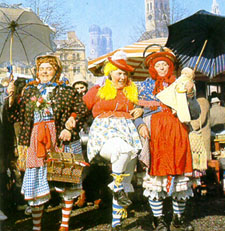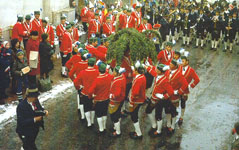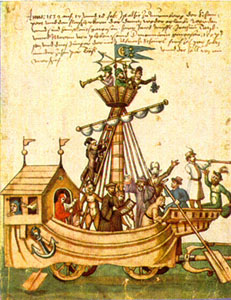
Dance of the Marktfrauen at the Viktualienmarkt Munich
The splendor of Vienna's masked balls had an influence on the innumerable balls that, at this time of the year, take place in other parts of the world. The rising middle class in the cities had begun to follow the example of the courts and staged masquerades, where one tries to disguise oneself, costume balls, where the imaginative costume is the main thing, and masked balls, where formal attire is complemented with an artistic or exotic mask or halfmask.
More than 300 balls are staged during the Viennese Fasching. The kick-off is with the Emperor's Ball in the Hofburg (royal castle), where livereed lackeys greet the guests and where a sumptuous dinner is served in beautifully decorated surroundings. Missing are the shouts of "helau" and "alaaf" one hears in Cologne. The guests in traditional Fasching spirit, born of the more southernly lightheartedness of the region, waltz into the night (see Joh. Strauss, Die Fledermaus).
Also hosted at the Vienna Hofburg are the physicians' Aerzteball and the ball of the Vienna Kaffeesieder (coffee brewers); the Rudolfina- Redoute takes place there as well. Beautifully decorated with flowers, the Rathaus (town hall) invites to the Blumenball (flower ball). The Vienna Philharmonic hold the Philharmonikerball in the Musikverein whose building and orchestra are famous for the annual New Year's concert m.c.ed by Walter Cronkite for PBS broadcasts. If you love sweets, the Vienna Zuckerbäckerball (confectioners' ball) in the Austria Center is the place to go. The high point of the season, however, is the "Opernball" at the Musentempel where VIPs from around the world are entertained with dining and waltzing way into the night.
Munich residents don't enjoy organized revelry. Their Rose Monday parade was canceled a few years ago for lack of participation. Instead there are artists balls, private parties, redouten (masked balls with historical themes) at which traditionally the Münchner Francaise--a 19th century contra dance--is danced at midnight. There are also gala theater performances and concerts. A Munich native will tell you that the Fasching at his home town is more gemütlich than the noisy celebrations in Cologne. Fasching, he maintains, has more heart and more soul.
A very old feature of Munich's Fasching is the dance of the Marktfrauen (market women) of the Viktualienmarkt. They dance in comical costumes on Shrove Tuesday, and you don't have to be a Marktfrau to participate!

Famous is the Schäfflertanz, the hoop dance of the Coopers' Guild, which is presented only every seven years. For a whole month the coopers dance on the Marienplatz and other places around Munich. It originated in 1463 after the plague had swept the land. The courageous coopers were the first citizens who went out into the streets, and with all kinds of dances and merrymaking they tried to lure people out of their houses again.

The Nürnberger Schembartlaufen (Schembart-run), a spirited parade of bearded masks referred to as "Schönbart", is organized by the journeymen and masters, notably the butchers, of Nuremberg. Its origins are found in the insurrection of the local craftsmen, who in 1348 and 1349 rebelled against the town's powerful oligarchy. The butchers, who had not joined the rebellion, were granted the right to perform a special dance at Fastnacht. They had the privilege to wear masks, perform dances, engage in fencing matches and to parade. To protect the dancers, "runners" were appointed to guard them. Gradually the runners developed their own performances, which finally became the main attraction.
It was recorded in the "Schembartbücher," beautifully illustrated books, which cover the period from 1430 to 1540 and show the various costumes worn, street scenes with dancers, the float with its central theme, and men on horse-like structures. Fools dressed in their traditional costume of donkey ears and bells, carrying clubs, cleared the path for the costumed characters. They also populated the central float, the "Hell." We are even told the names of the leaders of the various groups of participants.

Fasching is not limited to the big cities. Even the smallest villages compete with each other in arranging parades, and they elect princes of their own. In the Alpine areas one still finds regional variations of the older Fas(t)nacht celebrations like the Rudenkirtag in Sierning/Styria, the Schemenlaufen in Imst, or the burying or burning of the spirit of Fastnacht. Even in the mountain areas there is Skifasching, celebrated with gusto by locals and tourists alike.
The Schellenrühren (ringing of bells) in Mittenwald takes place on crazy Thursday, the first of the six final days of the Fastnacht. Schellen (bells), actually Kuhglocken (cowbells), play a large role in the Alpine culture. A good example is the Klausjagen in Küssnacht (Switzerland).
For the Karneval-Vereine in Windsor, Can., Milwaukee, Chicago, Cincinnati, Sun City, AZ, and Indianapolis the Cologne Karneval provides the model. A delegation from Indianapolis visited Cologne, their sister city, and participated in the Cologne Karneval as honored guests. They were there to learn first-hand and Cologne sent a group of Rote Funken (Red Sparks) to Indianapolis. At the 1999 North-American Narrentreffen (fools' meeting) in Las Vegas, a Prince and Princess were chosen to rule over the North-American fools. The event was video-taped by the Westdeutsche Rundfunk (WDR) for German Television.
Many North-American clubs, however, celebrate their costume or masked balls in the tradition of the Bavarian/Austrian Fasching. Rosemarie Leisner Gregory and Myra Lee Goff, in "Kindermaskenball Past and Present: 150 Years of Heritage" (Austin: Eakin Press), describe their memories of children's masked balls and parties and all the enjoyment they derived from it.
Viennese balls have become very popular in the last few years. They are no longer put on only by Austrian or German Clubs. None-ethnic organizations sponsor them as fund-raisers for charitable purposes or just for the sheer enjoyment of wearing formal dress.
Ruth Reichmann
IUPUI Max Kade German-American Center
Waas-Frey et al, Alte Br&aum;uche, frohe Feste, Allianz, Ostfildern: Mairs Geograhischer Verlag, 1984
Erich, Oswald A, and Beitl, Richard, Wörterbuch der deutschen Volkskunde, Stuttgart: Alfred Kröner Verlag, 1996, ISBN 3-520-12703-2